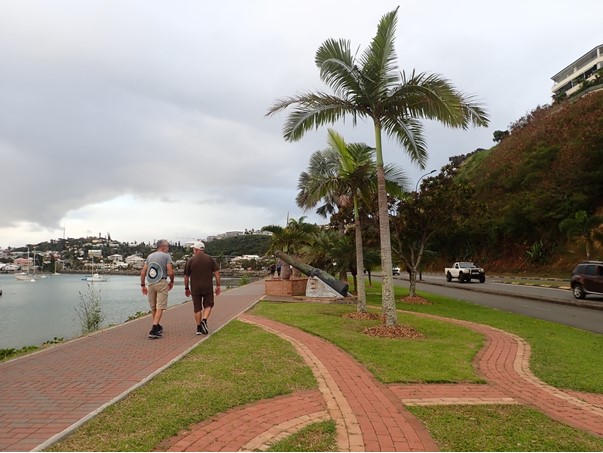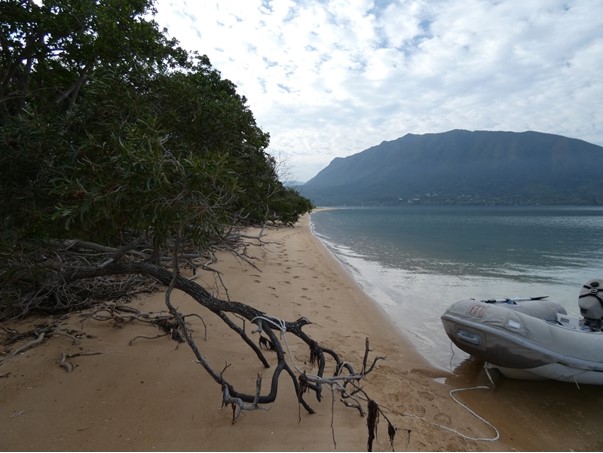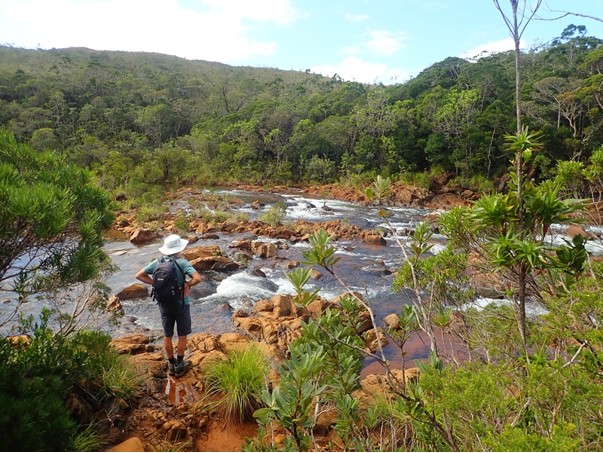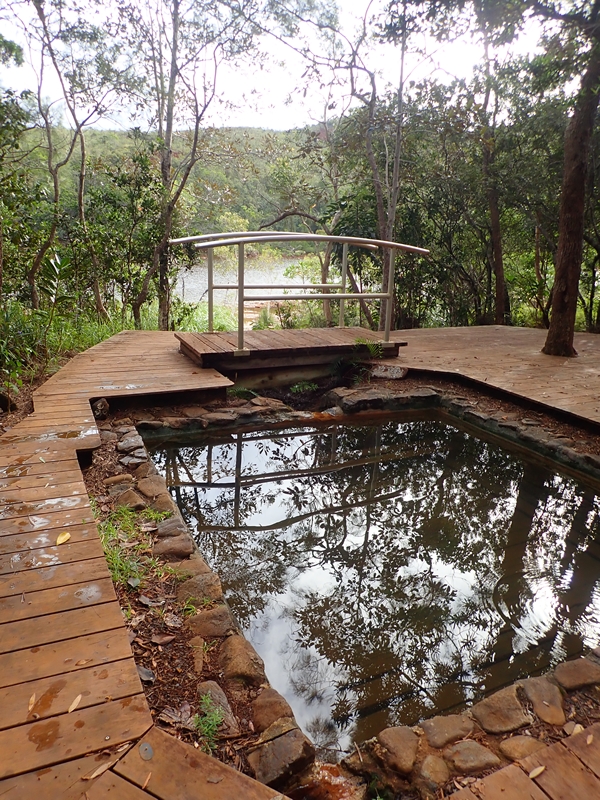Baie du Prony 22:22.9S, 166:54.9E

Our first day in Noumea was spent on chores. Phil went to check in with the marina and clear us through customs while Sarah started getting Serenity back into harbour mode: moving the stuff that gets piled on our double berth during passages and getting things out of storage. She also hosed the salt off everything on deck, a job made easier by the incredibly high water pressure though Sarah was soaked in the process. The woman from Bio-Security visited us and removed all our remaining fruit and vegetables (we could probably have kept some if we had been less honest) and told us we could take our Q flag down. You fly the Q flag when arriving in a new port to say your vessel is healthy – something that has acquired new meaning in the last couple of years. Having no fresh food left we went to the bistro in the marina for an early supper and a beer then slept for more than 12 hours.
The municipal market is open each morning with 3 halls full of fruit and veg vendors, a fish market and, being a French territory, a bakery selling baguettes and croissants. Our first stop the next morning was the market to replenish supplies. It’s right next to the marina so easy for buying fresh regularly and there was a great mix of tropical produce and things like peppers and courgettes that have been hard to find in other island markets – probably the French influence. On our second day we had to attend the pharmacy for a free PCR test (both negative), then we spent a week in the marina continuing to recover from the passage, looking around the town and getting to know the other cruisers on our pontoon. There were a number who left New Zealand at the same time as us so we were able to compare experiences of the passage.
New Caledonia has the world’s second largest reef system which is showcased at the small but interesting aquarium 45 minutes walk south of Noumea.
The walk to the aquarium took us along pleasant footpaths around the harbour and beaches We also visited the town museum which was small and a bit chaotic, and gave an impression of a troubled history. The population is split roughly 50/50 between the French and the native Kanak and the fight for more equal representation has led to tensions that don’t always seem to have been well handled by the ‘metropolitan’ French.
On the day we visited the museum the town’s main park was filled with this colourful market that seemed to be showcasing the produce of the various communes on Grand Terre. After a week in Noumea it was time to get out and explore so we checked out of the marina and motored 10 miles south of the town to Ile Bailly, one of many islands in the lagoon. We found a sheltered anchorage where we were joined by Rebell. The island, like many in the lagoon, is a nature reserve and we were able to walk on the beach but there were no paths into the interior. We did see a turtle from the shore and a couple of dolphins visited the anchorage. We enjoyed our first swim in the sea, although Sarah’s was cut short when she was stung by some small jellyfish!
Our first New Cal beach
Serenity and Rebell share a peaceful anchorage We spent a quiet Saturday on board, watching the locals at play in boats and on the beach then, with a brisk westerly wind forecast on Sunday, we set off for the 30 mile trip to Baie du Prony at the southern end of Grande Terre. We had a great windward sail as far as Canal Woodin, which separates the main island from Ile Ouen, where we had to motor into the wind for a few miles before we could sail again up through Prony to two sheltered anchorages at its northern end. Having seen very few other yachts it was a surprise when we opened up the entrance to Carenage to see a number already anchored there, so we turned right into Kauri Bay where there was only one other boat and dropped anchor in 12 metres. Despite being so sheltered Prony is virtually uninhabited, possibly due to the high levels of metals and minerals in the soil making it an unhealthy place. We had been warned that the mud from our anchor here would stain the decks red if not washed of immediately. In the 1800’s the French had a penal colony here and the convicts were employed in stripping the shores of trees which were used to build Noumea. Once the penal colony left the miners moved in and stripped even more vegetation in search of minerals (Little New Caledonia is the world’s 3rd largest producer of nickel after Russia and Canada). The area had made some recovery before a new huge nickel mine opened in recent years and we could see the glow of its lights over the hill from our anchorage at night. The unsettled weather we saw while waiting to leave New Zealand and on our passage up here has continued with a succession of troughs bringing strong winds and rain and stopping the steady trade winds from developing. Between rain storms that enabled us to keep our water tanks topped up we managed to walk some of the hiking trails that are marked in this area.
Walking past the ruins of the penal colony
Anchored in Kauri Bay, before the crowds arrived
The footpath crossed this river but after the heavy rain we decided not to try it
A highlight of this anchorage is the natural hot pool. It was only 32 degrees but still pleasant for a soak after a hot walk On Thursday we suddenly found the bay filling up: it was Bastille Day and French sailors were taking advantage of the holiday to have a long weekend, but on Saturday we found a mooring free off the north side of Ilot Casy, in the middle of Baie du Prony so spent the day there. It was a small island but had a pleasant walking trail. We also went snorkelling for the first time since arriving – nice to be back in the water but not warm enough to stay in long.
White sand and clear water at Ilot Casy. Now we know we are back in the tropics
Interesting plant life on the island
Moored at the north end of the island. The shore was steep too, but it still felt very close!
The fly in the ointment – the nickel mine working day and night Today, as the French sailors started to make their way back to Noumea, we had a good sail the few miles across the bay to our current anchorage in Anse Majik where we are on a mooring provided by the authorities. These moorings are put in so that boats don’t need to anchor, this protects the fragile corals and sea grasses. Sent from Mail for Windows |













